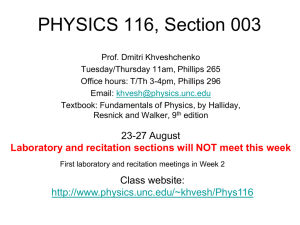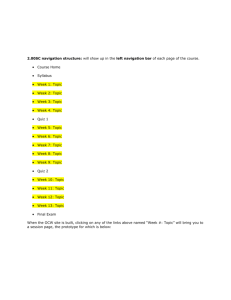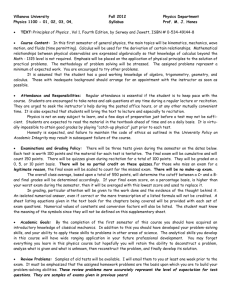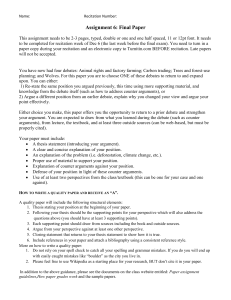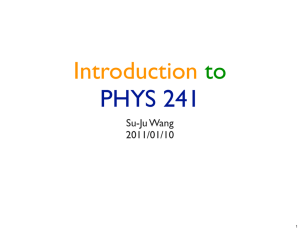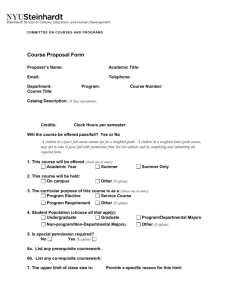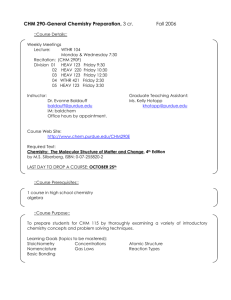BUS1000: INTRODUCTION TO BUSINESS - Blogs@Baruch
advertisement
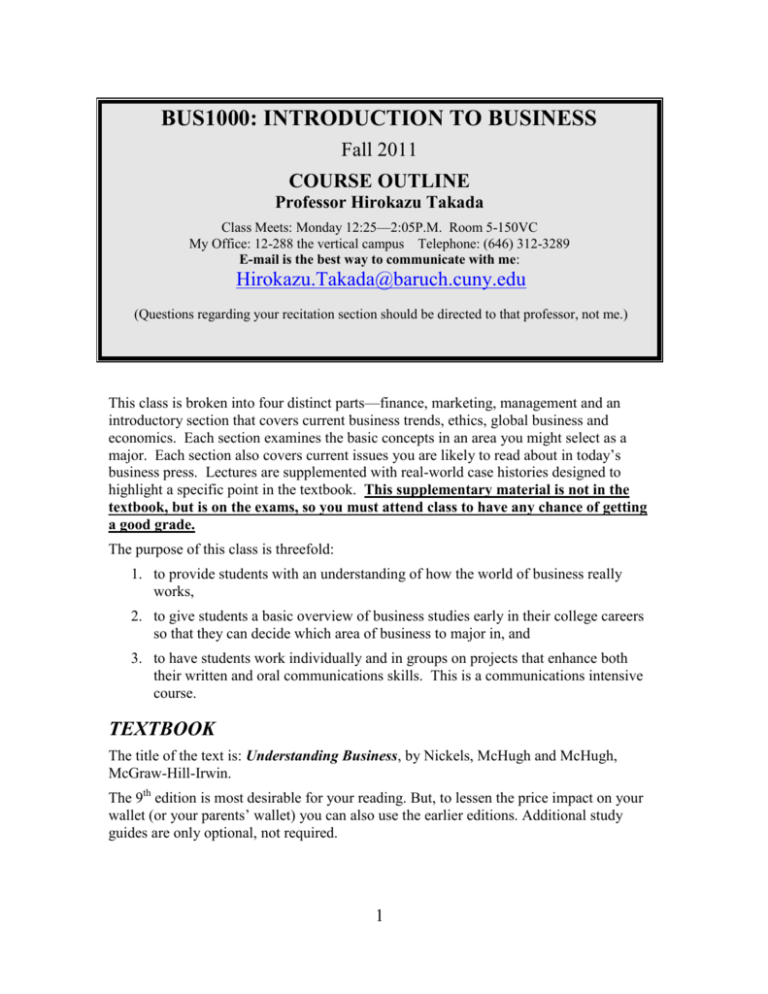
BUS1000: INTRODUCTION TO BUSINESS Fall 2011 COURSE OUTLINE Professor Hirokazu Takada Class Meets: Monday 12:25—2:05P.M. Room 5-150VC My Office: 12-288 the vertical campus Telephone: (646) 312-3289 E-mail is the best way to communicate with me: Hirokazu.Takada@baruch.cuny.edu (Questions regarding your recitation section should be directed to that professor, not me.) This class is broken into four distinct parts—finance, marketing, management and an introductory section that covers current business trends, ethics, global business and economics. Each section examines the basic concepts in an area you might select as a major. Each section also covers current issues you are likely to read about in today’s business press. Lectures are supplemented with real-world case histories designed to highlight a specific point in the textbook. This supplementary material is not in the textbook, but is on the exams, so you must attend class to have any chance of getting a good grade. The purpose of this class is threefold: 1. to provide students with an understanding of how the world of business really works, 2. to give students a basic overview of business studies early in their college careers so that they can decide which area of business to major in, and 3. to have students work individually and in groups on projects that enhance both their written and oral communications skills. This is a communications intensive course. TEXTBOOK The title of the text is: Understanding Business, by Nickels, McHugh and McHugh, McGraw-Hill-Irwin. The 9th edition is most desirable for your reading. But, to lessen the price impact on your wallet (or your parents’ wallet) you can also use the earlier editions. Additional study guides are only optional, not required. 1 GRADES 2/3rds of your grade comes from the large lecture quizzes—1/3rd comes from the recitation sections Lecture Quizzes: Quizzes 1 through 4 (25 percent each) Each quiz consists of 40 multiple-choice questions given during the final 50 minutes of class. A shortened lecture precedes each quiz. Each quiz is based on the material in the assigned chapters. “Boxes” and special discussions in the chapters are not included. Be advised that many questions come only from my lectures and are not in the book. Nor will I post them on Blackboard. If you are absent (or late) from that lecture you will not be able to answer those questions. The lecture-based questions are based on major points I discuss, not small details. The quizzes are non-cumulative. Your final grade is determined by averaging your top three quiz scores. If you take all four quizzes, your lowest score is dropped. If you miss a quiz, it becomes your lowest score. Because this is a jumbo class, no make-ups are given. No exceptions are granted. Bring a No. 2 pencil (and eraser) to the quiz or you may be forced to “buy one” with a point off your quiz grade. Needless to say, CHEATING IS NOT ALLOWED, and you will be reported to the authorities and receive a zero for the exam if you are caught. The same is true for PLAGARISM in the recitation assignments. Every semester a student or two is given a zero in the recitation sections for plagiarizing assignments. You may schedule an appointment with me if you think you were incorrectly graded. Be advised, however, that I will not sit and argue about each question. Recitation Assignments: (grade allocation based on100 percent) “Shadow-a-Company” Group Presentation and paper 60% Teams will be formed, which will pick a company (or be assigned one by the recitation professor) and write a paper, which is due the last day of class. Each team will make a 20 minute POWERPOINT presentation. Written assignments #1, #2 and #3 Class participation + Attendance 2 30% 10% THE “SHADOW-A-COMPANY” PROJECT This is a communications intensive course. In addition to attending the large lecture, you will break into 22-student recitation sections. The primary purpose of those recitation classes is to teach you to speak and write clearly about a specific company. You will pick (or be assigned) one of the following companies. (Your recitation professor may change the list to suit his or her expertise.) You will then break into six groups of three/four students each. The initial group of companies is: 1. Polo Ralph Lauren Corp (RL—NYSE—apparel retailer) 2. Sprint Nextel Corp (S—NYSE—telecommunications company) 3. Charles Schwab (SCHW—NYSE—discount brokerage firm) 4. Microsoft (MSFT—NASDAQ—computer software company) 5. Target Corp (TGT—NYSE—general merchandiser) 6. Walt Disney Co (DIS—NYSE—entertainment company) 7. Marriott International Inc (MAR—NYSE—hotel) 8. Yum! Brands Inc (YUM—NYSE—restaurants) During the semester you will research your company and towards the end of the semester make a group presentation about that company. At the end of the semester you will hand in a written paper detailing your findings—including stock price changes, issues affecting the company either positively or negatively and future prospects. Your recitation leader will provide you with details on length, style and other issues. ATTENDANCE, SEATING AND ABSENCE POLICY: 1. Attendance is taken by seat number. If you are not sitting in your assigned seat, you will be marked absent. It is your responsibility to make sure you are in the right seat. 2. A permanent seating chart will be posted by the second or third week of class. Please inform Mr. Grandone if you have special needs that require a seat up front. 3. My large lecture and the recitations each meet only 14 times. You are allowed a maximum of two absences in my large lecture, and two absences in the recitation. Lateness equals absence. Students who arrive late (or leave early) will be marked absent. Three absences from my large lecture and your final grade for my section of the course will drop by one letter grade—from, for example, B+ to B or C to C-. Three absences from the recitation section and your final grade for that section will drop by ADDITIONAL points as determined by that professor. 4. Tardy students distract from the lecture as they walk across the floor to their seat. Furthermore, business values punctuality. Therefore, if you are more than 30 minutes late, I will sometimes refuse you admittance. If you are more than 30 minutes late, do not bother coming. 3 Large Lecture Dates 1. August 29th Topic Chapters Introduction Recitation Sections Date Recitation Activities 1. August 26th Introduction and team formation: Pick (or be assigned) one of the companies above (or one that your recitation professor substitutes) that you will follow throughout the semester. Chapter 1: Business Environment 2. September 12nd Chapter 2: Economics 2. Sept. 2nd Chapter 3: Global Markets 3. Chapter 4: Ethics September 19th 3. Sept. 9th The recitation professor will explain how to do college level research (no encyclopedias or Wikipedia). Introduction to the tutorial: “The Beginner’s Guide to Business Research” at http://www.baruch.cuny.edu/tutorials Ethics Discussion: Your recitation professor will assign a topic or article for discussion. Hand in Written Assignment #1: learning to do college level research: Use the research tools in the tutorial to learn more about your company. Submit a three-page, typed, “fact-based” summary of what you found and how you found it. Be sure to include the stock price. 4. September 26th EXAM 1 4. Sept. 16th 4 Learning to use the Wassserman Trading Floor (Meet there—ground floor of the library) 5. October 3rd 6. October 17th Finance Chapter 19: Stock Market 5. Sept. 23rd 6. October 4th Hand in Written Assignment #2: How to write an effective business memo: Search the internet for guidelines for writing a business memo. Also, find some sample memo formats. Print out and bring to class. No printouts = no points. Write a memo to your recitation professor. Professor will summarize. 7. October 14th Primer on Financial Literacy: Discussion of your basic personal financial concepts such as credit scores. Handout assigned for you to read before class. 8. October 21st How to make a PowerPoint presentation: Research and write down some of the basic concepts and commands for making PowerPoint slides. Students will present to the others in class. Chapter 13: Marketing 9. October 28th Discussion of the basics of Excel spreadsheets Chapter 14: New Products and Pricing 10. Nov. 4th Hand in Written Assignment #3: Solving the Excel spreadsheet problem: Discussion and solution by recitation professor. 11. Nov. 11th The basics of making an effective presentation 12. Nov. 18th Presentation #1 and Presentation #2 Chapter 20: Financial Institutions Chapter 17: Accounting Chapter 18: Financial Management 7. October 24th 8. October 31st EXAM 2 9. November 7th Marketing 10. November 14th 11. November 21 Chapter 15: Distribution st Practice use the Wassserman Trading Floor—(Meet there) Chapter 16: Promotion 12. November 28th EXAM 3 5 13. December 5th 14. December 12nd Management Chapter 5: Forms of Business Ownership 13. Dec. 2nd Presentation #3 and Presentation #4 14. Dec. 9th Presentation #5 and Presentation #6 Chapter 7: Leadership Chapter 8: Organizational Structure Chapter 10: Motivation Last Exam (not cumulative) is given during final exam week 6 7
